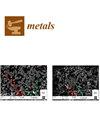Effects of In Situ TiB2 on the Microstructural Evolution, Mechanical Properties, and Friction Behavior of the Al-Si-Cu Alloys Processed by Laser Powder-Bed Fusion
IF 2.5
3区 材料科学
Q3 MATERIALS SCIENCE, MULTIDISCIPLINARY
引用次数: 0
Abstract
In the present study, the densification behavior, microstructural evolution, mechanical properties, and friction behavior of a TiB2/Al8SiCu composite and Al8SiCu alloy manufactured by laser powder-bed fusion (PBF-LB) were systematically investigated. The results confirm that the addition of in situ TiB2 particles into Al8SiCu alloys reduce the volumetric energy density required for a high-density TiB2/Al8SiCu composite. The TiB2 particles promoted a transformation of columnar to equiaxed crystals and the formation of high-angle grain boundaries. The grains on the vertical direction of the PBF-LBed TiB2/Al8SiCu composite were much finer than those of the PBF-LBed Al8SiCu alloy. The addition of TiB2 promoted the grain refinement of the Al8SiCu alloy, of which the average grain size decreased from 15.31 μm to 7.34 μm. The yield strength (YS), ultimate tensile strength (UTS), and elongation (El) of the PBF-LBed Al8SiCu alloy were 296 ± 6 MPa, 517 ± 6 MPa, and 11.7 ± 1.0%, respectively. The PBF-LBed TiB2/Al8SiCu composite achieved a balance between strength and ductility with a yield strength of 328 ± 8 MPa, an ultimate tensile strength of 541 ± 3 MPa, and an elongation of 9.1 ± 0.7%. The increase in strength mainly resulted from grain boundary strengthening, dislocation strengthening, load-bearing strengthening, solid-solution strengthening, and Orowan strengthening, of which the dislocation strengthening and Orowan strengthening were critical. The enhanced hardness associated with the grain refinement and the formation of the in situ TiB2 particles also led to an enhanced tribological performance, of which reductions in the average friction coefficient from 0.655 to 0.580 and wear rate from 1.76 × 10−3 mm3/Nm to 1.38 × 10−3 mm3/Nm were found.原位 TiB2 对激光粉末床熔融法加工的铝硅铜合金的微观结构演变、力学性能和摩擦行为的影响
本研究系统地研究了通过激光粉末床熔融(PBF-LB)制造的 TiB2/Al8SiCu 复合材料和 Al8SiCu 合金的致密化行为、微观结构演变、力学性能和摩擦行为。结果证实,在 Al8SiCu 合金中原位添加 TiB2 颗粒可降低高密度 TiB2/Al8SiCu 复合材料所需的体积能量密度。TiB2 颗粒促进了柱状晶体向等轴晶状晶体的转变以及高角度晶界的形成。PBF-LBed TiB2/Al8SiCu 复合材料垂直方向上的晶粒比 PBF-LBed Al8SiCu 合金的晶粒细得多。TiB2 的加入促进了 Al8SiCu 合金的晶粒细化,其平均晶粒尺寸从 15.31 μm 减小到 7.34 μm。PBF-LBed Al8SiCu 合金的屈服强度(YS)、极限拉伸强度(UTS)和伸长率(El)分别为 296 ± 6 MPa、517 ± 6 MPa 和 11.7 ± 1.0%。PBF-LBed TiB2/Al8SiCu 复合材料实现了强度和延展性之间的平衡,屈服强度为 328 ± 8 MPa,极限拉伸强度为 541 ± 3 MPa,伸长率为 9.1 ± 0.7%。强度的提高主要源于晶界强化、位错强化、承载强化、固溶强化和奥罗旺强化,其中位错强化和奥罗旺强化至关重要。与晶粒细化和原位 TiB2 颗粒的形成相关的硬度增强也导致了摩擦学性能的提高,其中平均摩擦系数从 0.655 降至 0.580,磨损率从 1.76 × 10-3 mm3/Nm 降至 1.38 × 10-3 mm3/Nm。
本文章由计算机程序翻译,如有差异,请以英文原文为准。
求助全文
约1分钟内获得全文
求助全文
来源期刊

Metals
MATERIALS SCIENCE, MULTIDISCIPLINARY-METALLURGY & METALLURGICAL ENGINEERING
CiteScore
4.90
自引率
13.80%
发文量
1832
审稿时长
1.5 months
期刊介绍:
Metals (ISSN 2075-4701) is an open access journal of related scientific research and technology development. It publishes reviews, regular research papers (articles) and short communications. Our aim is to encourage scientists to publish their experimental and theoretical results in as much detail as possible. Therefore, there is no restriction on the length of the papers. The full experimental details must be provided so that the results can be reproduced. Metals provides a forum for publishing papers which advance the in-depth understanding of the relationship between the structure, the properties or the functions of all kinds of metals.
 求助内容:
求助内容: 应助结果提醒方式:
应助结果提醒方式:


